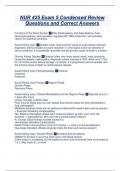NUR 425 Exam 5 Condensed Review
Questions and Correct Answers
Functions of the Renal System ✅Filter blood plasma, acid-base balance, fluid-
electrolyte balance, renin secretion, regulates BP, RBC production, and activates
vitamin D (Calcitriol) synthesis
Acute Kidney Injury ✅Sudden onset, most common cause is acute tubular necrosis,
diagnostic criteria includes an acute reduction in urine output and/or an elevation in
serum creatinine, it is potentially reversible and the primary cause of death is infection
Chronic Kidney Disease ✅Gradual (often over many years) onset, most commonly
caused by diabetic nephropathy, diagnostic criteria includes a GFR <60mL/min/1.73m
for >3 months and/or kidney damage >3 months, it is progressive and irreversible, and
the primary cause of death is cardiovascular disease
Acute Kidney Injury Pathophysiology ✅Prerenal
Intrarenal
Postrenal
Acute Kidney Injury Phases ✅Oliguric Phase
Diuretic Phase
Recovery Phase
Acute Kidney Injury: Clinical Manifestations of the Oliguric Phase ✅Typically occurs 1-
7 days after injury
Urinary changes (<400mL/day)
Fluid Volume (Make sure you can assess fluid volume status-are they dehydrated or
fluid overloaded?)
Metabolic Acidosis (Acids are not getting excreted-buffer system gets used up quickly--
> Kussmaul breathing compensation)
Na+ Balance (Damaged tubules can't conserve sodium as well-->too much Na
excreted--> hyponatremia. Why don't we increase sodium intake?)
K+ Excess (Good kidneys excrete excess K+)
Hematologic disorders (Leukocytosis)
Waste Product Accumulation (urine isn't leaving --> urine is in the bloodstream)
Neurologic Disorders (Waste products irritate the brain and nervous system)
Acute Kidney Injury: Diuretic Phase ✅Immature fluid processing
OSMOTIC diuresis is occurring (high urea in the blood stream)
(Urine output is increasing, but the nephrons aren't fully functional) Daily urine output is
1-3 L. May reach 5 L or more
,The main concern is fluid/electrolyte balance
Acute Kidney Injury: Recovery Phase ✅Long term, return to baseline
May take up to 12 months for kidney function to stabilize
Acute Kidney Injury: Collaborative Care ✅Fluid therapy-restrictions related to acute
nature of kidney injury and ability to function-fluid restriction
Nutritional therapy-maintain adequate caloric intake, restrict Na+ and protein, increase
dietary fat and enteral nutrition
Renal replacement therapy (RRT)- peritoneal dialysis (PD), intermittent hemodialysis
(HD), and continuous renal replacement therapy (CRRT)
Etiology of Chronic Kidney Disease ✅The result of years of kidney injury that is of slow
progression and is irreversible.
Diabetic nephropathy: 45%
Hypertensive disease: 27%
Glomerulonephritis: 8.5%
Cystic kidney disease: 3%
Other: 16.5%
Chronic Kidney Disease effects on each body system ✅Psychologic: anxiety and
depression
Cardiovascular: HTN, heart failure, coronary artery disease, pericarditis, and peripheral
artery disease
Gastrointestinal: anorexia, nausea, vomiting, GI blleding, gastritis
Endocrine/Reproductive: hyperparathyroidism, thyroid abnormalities, amenorrhea, and
erectile dysfunction
Metabolic: carbohydrate intolerance and hyperlipidemia
Hematologic: Anemia, bleeding, infection
Neurologic: fatigue, headache, sleep disturbances, encephalopathy
Ocular: hypertensive retinopathy
Pulmonary: pulmonary edema, uremic pleuritis, pneumonia
Integumentary: pruritis, ecchymosis, dry/scaly skin
Peripheral neuropathy: paresthesias and restless leg syndrome
Chronic kidney disease clinical manifestations of the urinary system ✅Polyuria-results
from inability of kidneys to concentrate urine, occurs most often at night, and specific
gravity fixed around 1.010
Oliguria-occurs as CKD worsens
Anuria-occurs as CKD worsens and has a urine output lower than 40mL per 24 hours
Chronic kidney disease clinical manifestations-metabolic disturbances ✅Waste
product accumulation: Urea Nitrogen, creatinine, hormones
, Altered carbohydrate metabolism: Insulin remains in the blood longer (not excreted by
the kidneys).Insulin insensitivity
Elevated triglycerides:
Altered lipid metabolism. Hyperinsulinemia stimulates hepatic production of
triglycerides--> dyslipidemia. Remember that the #1 cause of death for CKD patients is
cardiovascular disease
Chronic Kidney Disease clinical manifestations: electrolyte and acid-base imbalances
✅K+: Elevated, now what are you worried about?
Na: Elevated, normal or low. Caused by dilution (fluid overload) vs Na retention (kidneys
responding to hypoperfusion)
Ca and Phosphate: (hypocalcemia & hyperphosphatemia --> calcium phosphate
deposits)
Mg: slightly elevated
Metabolic acidosis: kidneys not excreting hydrogen ion and ammonia as effectively
Chronic Kidney Disease clinical manifestations of the cardiovascular system ✅Fluid
overload causes: Hypertension-Left ventricular hypertrophy (left ventricle has to work
harder to pump extra fluid volume), as well as heart failure due to being overworked and
peripheral edema
Dysrhythmias-hyperkalemia
Uremic pericarditis
Chronic Kidney Disease clinical manifestations of the neurological system ✅Alterations
expected as renal failure progresses: attributed to increased nitrogenous waste
products, electrolyte imbalances, metabolic acidosis, atrophy and demyelination of
nerve fibers
Chronic Kidney Disease clinical manifestations of remaining body systems
✅Hematologic system: anemia, bleeding tendencies (impaired platelet function), and
infection
Respiratory system: fluid overload leads to pulmonary edema, uremic pleuritis, and
pneumonia
GI: stomatitis, uremic fector, anorexia, N/V
Musculoskeletal: low calcitriol
--> reduced calcium absorption --> bone demineralization --> osteomalacia/risk for
fractures
Integumentary: pruritis, uremic frost
Chronic Kidney Disease diagnostic studies ✅UA, 24 hr urine, serum creatinine, BUN
GFR
CBC, H/H, Metabolic Panel
Renal ultrasonography
Renal scan
CT scan




